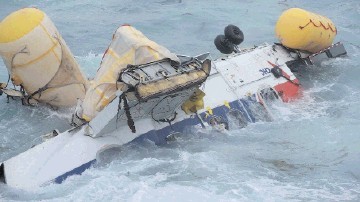
Training records for the co-pilot of the fatal Sumburgh crash suggested he had experienced some difficulties during a course with “managing the workload and becoming overloaded” at times.
The details were highlighted in the final report by the Air Accident Investigation Branch (AAIB) report on the incident which killed four people.
Survivors were briefed earlier on the report’s outcome which detailed a fatal lapse of 30 seconds when both pilots failed to notice the helicopter’s descending airspeed until it was in a “critically low energy state.”
On August 23, 2013 at 5.17pm a Super Puma helicopter carrying 16 passengers and two crew crashed in the sea on its approach to land at Sumburgh Airport.
In the report, the findings state the co-pilot joined the helicopter operator CHC in July 2012, just over year before the crash.
The co-pilot’s previous flying experience had been in single engine, single crew helicopters, in which he had also worked as a flying instructor.
The report states:”His training for North Sea operations was carried out by the operator. He completed a Multi-Crew Conversion (MCC) and Crew Resource Management (CRM) training course on 7 August 2012.
“On 9 August 2012, he started his training on the EC225 helicopter.
“His training records included comments which suggested he was experiencing some difficulties on the course, with managing the workload and becoming overloaded at times.
“On 23 August 2012 he was assessed as ready for the Licence Skills Test (LST); a comment was included in this training report which suggested he could be hesitant to act when required.
“The LST was completed successfully on 27 August 2012. Line flying training started on 6 September 2012 and steady progress was reported.
“The final training flight on the EC225 was on 12 October 2012 and the report indicated that further training was still required.
“In late October 2012 the UK offshore EC225 fleet temporarily ceased flying operations, as a result of two accidents and therefore the co-pilot’s line training on the EC225 was not completed.
“In December 2012 he started a differences course of training for the AS332 L2 helicopter.
“Training reports indicated good progress and the final line check was completed on 27 February 2013.
“It was recorded in the co-pilot’s flying logbook that, on 18 June 2013, he acted as PNF (Pilot Not Flying) for a LOC DME approach to Runway 09 at Sumburgh.
“On 10 to 11 June 2013, the co-pilot carried out eight hours of ‘Return to Service’ training in the EC225 flight simulator. He did not fly the EC225 at this time, but continued flying the AS332 L2.”
The report continued that following the incident, the co-pilot stated he did not consider that he had received training on the “specific duties” of the Pilot Not Flying (PNF) in respect of how to monitor the progress of an approach, or how to monitor the other pilot “during an instrument approach”.
It added: “Additionally, he considered that he had not received guidance as to when, as PNF, he should look outside during an approach to acquire the visual references required for landing.”
One of the crash survivors, Martin Tosh, said he felt “no anger” following the findings of the report.
Duncan Trapp, vice president for safety and quality at CHC Helicopter, said: “CHC deeply regrets the tragic Sumburgh accident, and we continue to extend our sympathies to the survivors and to the loved ones of those who died.
“Our priority is always the safety of our passengers and crews and we would like to thank the Air Accidents Investigation Branch (AAIB) for its thorough investigation.
“Although the AAIB makes no recommendations specific to CHC, immediately after the accident, and in the time since, we put in place additional measures to further improve safety. Among those actions, we have enhanced crew monitoring procedures and supported the industry-wide deployment of improved emergency breathing systems and training for offshore passengers and crew.
“We continue to lead and contribute to industry-wide efforts to further improve the safety of offshore helicopter transportation, including as a founding member of HeliOffshore.”